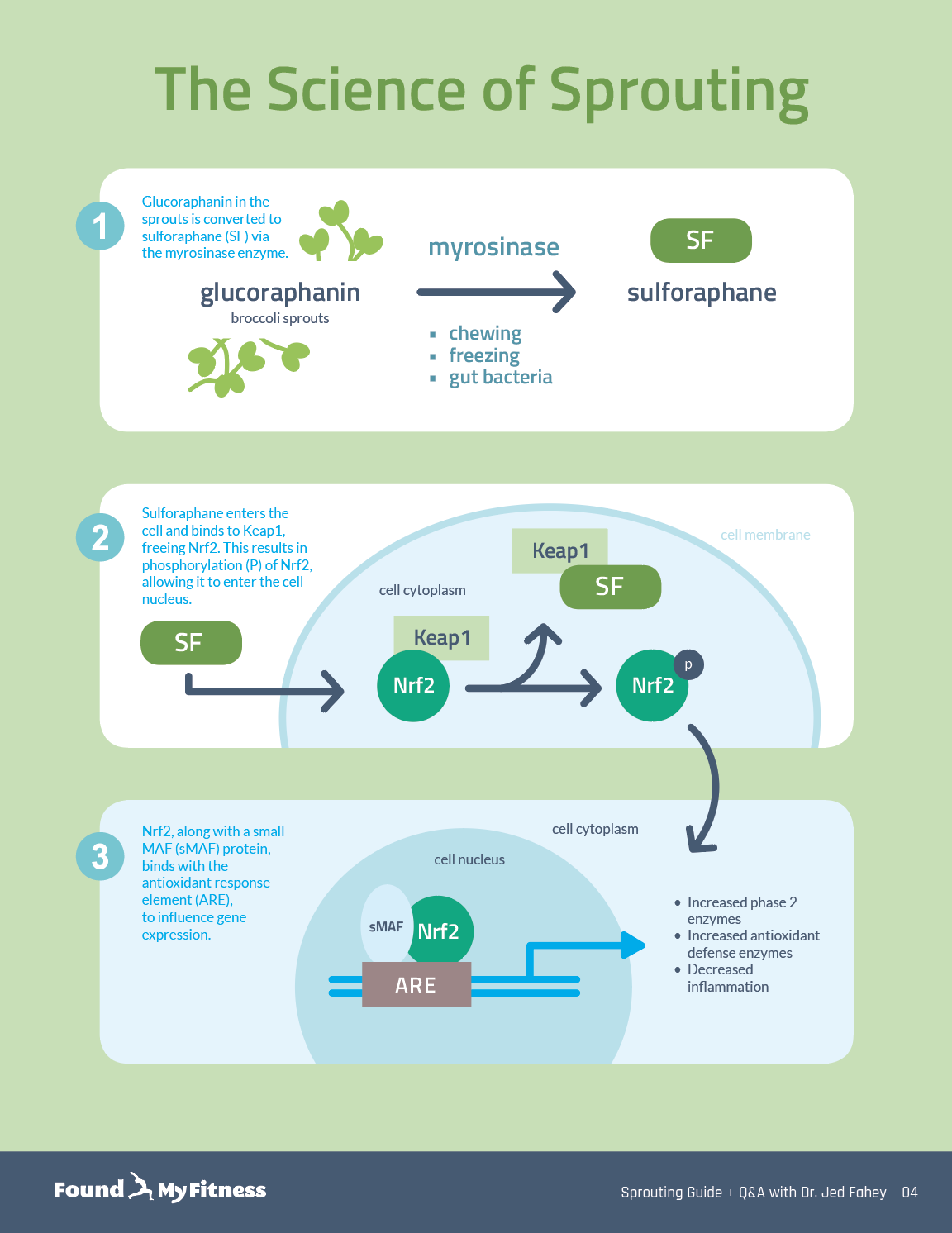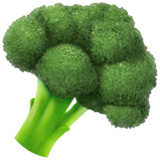What are sulforaphane's effects on cancer? | Jed Fahey
Enter your email to get our 15-page guide to sprouting broccoli and learn about the science of chemoprotective compount sulforaphane.
Broccoli sprouts are concentrated sources of sulforaphane, a type of isothiocyanate. Damaging broccoli sprouts – when chewing, chopping, or freezing – triggers an enzymatic reaction in the tiny plants that produces sulforaphane.

Get the full length version of this episode as a podcast.
This episode will make a great companion for a long drive.
Sulforaphane targets certain tissues, such as the prostate, breast, and bladder, where it exerts pharmacological effects that provide protection against cancer. In particular, sulforaphane promotes the activity of Nrf2, a transcription factor that regulates the expression of more than 200 cytoprotective enzymes. But the cytoprotective effects of sulforaphane may backfire in existing cancers, providing protection to mutant cells. In this clip, Dr. Jed Fahey describes sulforaphane's opposing effects on cancer.
[Dr. Patrick]: All right, let's move on to the next question, which was related to cancer. The question was, "Are there any studies that you know of that would suggest broccoli sprouts would be beneficial for a person who has already been diagnosed with cancer? If so, which cancers?"
[Dr. Fahey]: Yeah. So I've got to repeat the admonition caution here. I'm not a physician, I'm not your physician, and I don't give medical advice. I would... In that instance I would certainly eat a vegetable-based diet, a whole food vegetable-based diet. There are certainly clinical studies suggesting that there may be cancer therapeutic effects, but those studies are all in progress and I don't think there's...there is not scientific consensus that sulforaphane is a cancer therapy, or therapeutic, certainly. So it would be irresponsible to suggest that. My bias is that I certainly think that it is valuable in a cancer preventive lifestyle, trying to prevent cancers from starting.
So if you're diagnosed with cancer, especially if it's metastasized, it may actually not be wise to take sulforaphane, or a supplement or two, to go heavy on broccoli. We just...honestly we just don't know enough. We do know that upregulating NRF2 protects cells. And when you think about it, metastasized cancers, what's happening there? Those cells are growing faster than the rest of the cells around them, the rest of the body for that matter if you're an adult. They're growing fast, they're producing the products of respiration and oxidation, their mitochondria are cranking away. So if you support their mitochondria and enhance their ability to detoxify things, including perhaps cancer drugs, this may be a slippery slope.
We just don't know enough. And there are some animal model studies in which NRF2 is genetically upregulated, or knocked out. And I think those studies, the results of those studies suggest that caution is advised in cases where people have been diagnosed with cancer. But hopefully a lot more to come on that from studies that are underway and in progress in various parts of the world.
- [Dr. Patrick]: And just to add on as a comment, you know, speaking to prevention. I know there's been...there's... Some of the preclinical evidence that really excited me was there was a rat study. And I forget the group that published the study. But the rats were given sulforaphane, they were given it before they were given a chemical that causes bladder cancer. And the other group of rats were just given the chemical that causes bladder cancer. And the rats that were given the dose of the sulforaphane did not develop bladder cancer. And if they did, the tumors were much, much smaller in size. So again, preventative. You know, just more evidence that the preventative approach seems to be stronger.
There's also been the clinical evidence. It seems as though... And your...and you know better about this, Jed, about, you know, the tissues that sulforaphane may accumulate in more, you know, the bladder, prostate, breast, versus other tissues, or lungs. You know, I don't even know if we know all the differences. But the prostate seems to be one that at least clinically there's been a few studies showing that sulforaphane, ranging in dose, the higher the dose the more robust the effect. So 60 milligrams of sulforaphane a day was shown to slow the biomarker prostate-specific antigen, or PSA, which people with, you know, early prostate cancer or, you know, a risk of it or whatever have. And so slowing that by 86% is certainly, you know, a good thing.
[Dr. Fahey]: Yeah. So as a follow-up, shame on you, I think that first bladder cancer study you were talking about is also one that I was involved in.
[Dr. Patrick]: Okay, so at the beginning of the call I said I'd been following your work because you're every study. So pretty much every study that I cite almost Jed Fahey, Dr. Jed Fahey, is an author on. So it's just you're so prolific, I can't keep track of all your publications, Jed.
[Dr. Fahey]: Mostly a minor player. So in this case a minor player. A group in New Zealand, Rex Munday and an old, old colleague, actually the guy who, with Paul Talalay, put sulforaphane on the map, Yingsha Zhang, and I did this...did one of the rat studies, I think maybe the one you're talking about, with bladder cancer. And absolutely, this was benzyl isothiocyanate, as I recall, that we used, or sinigrin, allyl isothiocyanate. Which come from radish or daikon mustard seed.
So it's worth dwelling on this. When you think about what happens with sulforaphane, which most of you...I don't know, most of you don't. I do probably too much, to my detriment. But what happens? You ingest it. You take it in, the body sees it, your cells of your body see it, they actually take it in very rapidly, they conjugate it with glutathione, and they spit it back out. Then where does it go? It goes from the blood to the urine. Then where does the urine go? Unless you're on a Foley catheter, and most of us that are reasonable healthy aren't, although I've had that fun experience before. So your bladder stores urine up. What's in that urine? Sulforaphane and its conjugates. Well, what is bladder cancer? Bladder cancer is the epithelial cells of the bladder, most of them, the tissue lining that bladder, you know, a mutation forming and ultimately a tumor developing.
So bladder cancer, I still think, is the ultimate target for isothiocyanates because you're bathing that tissue in these protective compounds, essentially all the time. You know, you empty your bladder and immediately it starts filling back up again.
Certainly the prostate cancer is another example where mechanistically, or I should say "evidentiarily," we have...there's evidence. The cause and effect is a little harder to see, but the bladder cancer model is just beautiful.
A measurable substance in an organism that is indicative of some phenomenon such as disease, infection, or environmental exposure.
An antioxidant compound produced by the body’s cells. Glutathione helps prevent damage from oxidative stress caused by the production of reactive oxygen species.
An essential mineral present in many foods. Iron participates in many physiological functions and is a critical component of hemoglobin. Iron deficiency can cause anemia, fatigue, shortness of breath, and heart arrhythmias.
Byproduct of a reaction between two compounds (glucosinolates and myrosinase) that are found in cruciferous vegetables. Isothiocyanates inhibit phase I biotransformation enzymes, a class of enzymes that transform procarcinogens into their active carcinogenic state. Isothiocyanates activate phase II detoxification enzymes, a class of enzymes that play a protective role against DNA damage caused by reactive oxygen species and carcinogens. Examples of phase II enzymes include UDP-glucuronosyltransferases, sulfotransferases, N-acetyltransferases, glutathione S-transferases, and methyltransferases.
Tiny organelles inside cells that produce energy in the presence of oxygen. Mitochondria are referred to as the "powerhouses of the cell" because of their role in the production of ATP (adenosine triphosphate). Mitochondria are continuously undergoing a process of self-renewal known as mitophagy in order to repair damage that occurs during their energy-generating activities.
A chemical that causes Parkinson's disease-like symptoms. MPTP undergoes enzymatic modification in the brain to form MPP+, a neurotoxic compound that interrupts the electron transport system of dopaminergic neurons. MPTP is chemically related to rotenone and paraquat, pesticides that can produce parkinsonian features in animals.
A protein typically present in the cytoplasm of mammalian cells. Nrf2 can relocate to the nucleus where it regulates the expression of hundreds of antioxidant and stress response proteins that protect against oxidative damage triggered by injury and inflammation. One of the most well-known naturally-occurring inducers of Nrf2 is sulforaphane, a compound derived from cruciferous vegetables such as broccoli.
A chemical reaction in which an atom, molecule, or ion loses one or more electrons. Oxidation of biological molecules is associated with oxidative stress, a key driver of many chronic diseases.
Cellular respiration is the process by which oxygen is utilized to generate energy inside of the mitochondria.
An isothiocyanate compound derived from cruciferous vegetables such as broccoli, cauliflower, and mustard. Sulforaphane is produced when the plant is damaged when attacked by insects or eaten by humans. It activates cytoprotective mechanisms within cells in a hormetic-type response. Sulforaphane has demonstrated beneficial effects against several chronic health conditions, including autism, cancer, cardiovascular disease, diabetes, and others.
Get email updates with the latest curated healthspan research
Support our work

Every other week premium members receive a special edition newsletter that summarizes all of the latest healthspan research.
Sulforaphane News
- Sulforaphane extends lifespan and healthspan in worms via insulin and insulin-like growth factor-1 signaling.
- Paul Saladino, MD explains how we may have overstated the health benefits of plants and especially sulforaphane
- NRF2 much of a good thing (December 2017)
- A pilot trial finds sulforaphane treatment increased glutathione levels in the blood & hippocampus region of the brain in healthy people.
- A new study found sulforaphane (found in broccoli sprouts) improved behavior & social responsiveness in children with autism.





































































